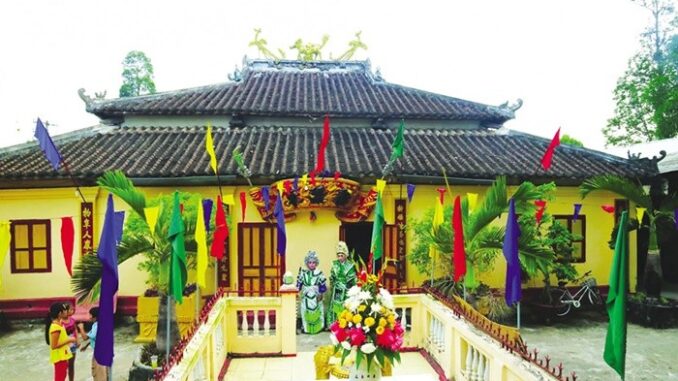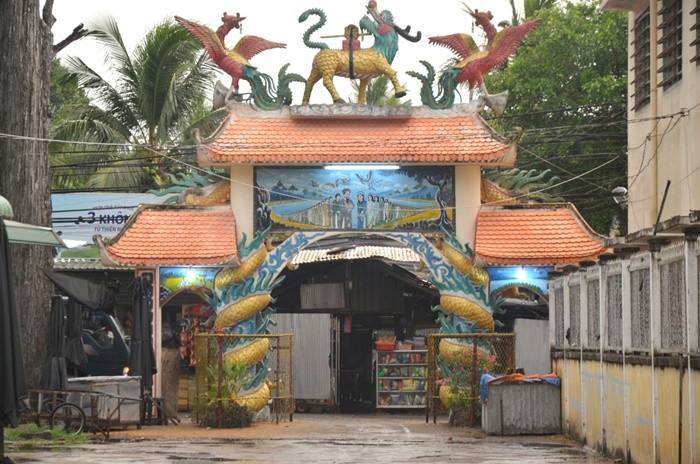
With bold Vietnamese feudal architecture, Tan Loc Dong communal house has attracted visitors by its peace and quiet through its ancient and dignified beauty with the temple’s soft curved roof system.
Can Tho be land that always brings many interesting and unexpected things to visitors because of its vibrant and rhythmic life through bustling floating markets? Or the clarity and dreaminess of fruit-laden orchards. However, there are destinations that make people ponder and reflect on a bygone era, which are ancient houses or sacred temple buildings. Somewhere, the nostalgic beauty with the unique architecture of the temples and pagodas makes people slow down and find the serenity in their souls.
And on this trip, we return to Cu Lao Tan Loc to admire the ancient, sacred with curved roofs, delicately carved of Tan Loc Dong communal house. Unique architecture
Unique architecture
Where is Tan Loc Dong communal house in Can Tho?
Location: Tan My 1 – Tan Loc Ward – Thot Not District – City. Can Tho
Located in the area of Tan My 1 – Tan Loc Ward – Thot Not District, Tan Loc Dong communal house is about 40km southwest of Can Tho city center. With an age of nearly 100 years, this ancient communal house still retains the traditional beauty of national characteristics. Especially, in the spiritual life of Thot Not people in particular and Can Tho people in general.
History of Tan Loc Dong communal house
In 1787, the communal house was built when the Nguyen, Cao and Vo families assigned to this land to establish hamlets and reclaim wasteland. At first, when it was newly built, the suspension was roofed with simple bamboo leaves in Cu Lao Cat, now Tan Loc ward. The purpose is to worship the gods.
In the early 19th century, people flocked to Cu Lao Cut to settle down and settle down. Therefore, Tan Loc Dong village was formed soon after. And this communal house has also been renovated with the name Tan Loc Dong communal house.
On November 29, 1852 (Nham Ty), King Tu Duc ordained Bon Canh Thanh Hoang to the villagers. Since the ordination, all business, business and trade activities have been developed, the life of the people in the village is better, more prosperous and happier.
At the beginning of the twentieth century, the population became increasingly crowded. And the area of the communal house is quite small, the roads to the communal house are not convenient, there is a lack of landscape and there is no space to organize the village festival. Therefore, people in the village gathered and decided to move the communal house to a new location on the land donated by Tran Thi Trieu.
In 1922, the communal house was started and rebuilt with more solid materials. In 1925, the communal house was completed and this house has existed to this day.
After many renovations, Tan Loc Dong Can Tho communal house increasingly possesses a spacious appearance, expanded premises, and a more airy communal house landscape. And this is also the largest communal house, typical and pride of Can Tho people.
On May 22, 2017, Tan Loc Dong communal house was approved by the People’s Committee of Ho Chi Minh City. Can Tho is recognized as a city-level cultural and historical relic. The ancient communal house is nearly 100 years old
The ancient communal house is nearly 100 years old
Unique architecture of Tan Loc Dong communal house – Can Tho
Size of the family
Tan Loc communal house in Dong Can Tho is designed in the shape of the letter Nhat with the scale of the communal house up to 2,884m2. Currently, the main function of the communal house includes the main items: Tam Quan gate, martial arts, martial arts, main hall, guest house, kitchen, fairy master’s house…
Architecture of the communal house
As a communal house possessing the beauty of traditional Vietnamese architecture, the structure of the communal house is built in the style of a four-pillar house that is closely linked with each other by tight and solid mortise. The roof system of the communal house is built in the shape of the word Bat or commonly known as the gradual bowl with 3 floors of yin and yang tiles. The communal house column system is built continuously, consecutively, creating a uniform, solid, and good-bearing architectural system. Thanks to that, it supports the trusses and the roofs above.
In general, the communal house consists of 16 large columns. Each column has a width of up to 1.4m and the main column is up to 10m high. On the roof of the communal house is decorated with the image of a dragon adoring the moon. Interspersed with that are the lines, ridges, lines with familiar frilled roofs bearing the characteristics of Vietnamese feudal architecture in the past. Therefore, the house always possesses a dignified and unique beauty.
Not only that, the communal house is also decorated with reliefs and parallel sentences. On the column, it is inlaid with delicate, flexible and soft patterns that look very attractive. The temple of Tan Loc Dong still preserves the ancient wine jars dating from the Qing Dynasty.
Most of the wooden details of the communal house are linked together by brackets and truss mouths. When inlaid with patterns and textures, the trusses and rafters will be smooth and smooth by the craftsmen. And the truss column system is coupled with a perforated tenon instead of using nails and screws. This will make the house stronger and more stable. Bold with ancient Vietnamese architecture
Bold with ancient Vietnamese architecture
Triple gate
Built with the main material from reinforced concrete is very solid and solid. The roof of the gate is designed in the shape of a bowl and is covered with fish-scale hook tiles. On the roof system, it is decorated with soft curved blades and do not forget to engrave the national language “Dinh Than – Tan Loc – East” with a great picture of Han Nom characters.
The entrance to the main gate is embossed with the image of two dragons hugging tightly around the column. Below is a statue of Kim Quy. In particular, the gate of Tan Loc Dong communal house is elaborately decorated with the image of the four spirits “Long – Lan – Quy – Phung”. The frescoes are reproduced and clearly show the ancient stories about Au Co and Lac Long Quan, or the theme of the village… looks very soulful and unique. Triple gate
Triple gate
Family martial arts
Tan Loc Dong communal house martial arts is a place dedicated to singing troupes to serve the people during festivals held at the communal house. To create an airy space, the wall of martial arts will be built solidly and attached with wooden bars. The purpose of taking the outside wind to create a cool place for this place.
The two sides of the martial arts are a large space with a wooden stand built on three steps for people to sit and watch and sing easily. That is the difference between the communal house and other communal houses in Can Tho.
Royal martial arts
In martial arts, it is the altar of the National Ancestor Hung Vuong and the altar of President Ho Chi Minh located in the center. On both sides are the altars of Pho Bai, Dai Bai, Dong Hien, Chanh Te, and Tay Hien. Inside the family’s martial rules
Inside the family’s martial rules
Main power
It is the most decorated place of the communal house and worships Bon Canh Thanh Hoang. The two sides of the main hall are also arranged with many other altars such as: Tien Hien, Huu Ban, Bach Ma, Ta Ban, Thai Giam, and Tien Thuong altar.
Like many other communal houses in the South, Tan Loc Dong communal house also worships heroes and martyrs who have made great contributions to building the country and protecting the homeland and villages. Or the forefathers who had merit in reclamation, establishment of hamlets, and communes to help villagers live a prosperous, happy and prosperous life… Main altar
Main altar
Artistic value
In addition to the unique architecture, Tan Loc Dong communal house is also a communal house that preserves artistic values through sophisticated and sophisticated carved images that clearly show the images of Long – Lan – Quy – Phung, flowers, leaves and strings. ..on cover, diaphragm, couplets. Or through frescoes on the theme Mai – Bird; Lotus; Tam Da. In addition, the communal house also preserves special values such as: identity, worship, worshiping objects nearly 100 years old.
Tan Loc Communal House Festival East Can Tho
Currently, Tan Loc Dong communal house festival usually includes 2 main festivals: Organize a festival at the communal house
Organize a festival at the communal house
Landing ceremony
Meaning associated with local people’s life. This is a festival symbolizing the ceremony of going down to the fields, opening the plowing season, giving thanks to heaven and earth, the gods have helped the villagers have a good harvest. This is the biggest festival of the year and is held on April 11-13 of the lunar calendar.
Upper field ceremony
The meaning of this festival is organized by the villagers to show their gratitude to God Thanh Hoang. May the rain be favorable and windy, the nation and the people safe. At the same time, this is a festival dedicated to the great merits of heroes and martyrs, who have made great contributions to protecting and preserving the country. The festival is usually held on November 20 and 21 of the lunar calendar.
Dragon Boat Festival
On the 4th – 5th day of the 5th lunar month, the people of Cu Lao Tan Loc hold the Tet Doan Ngo festival at the communal house with the meaning of killing insects that damage crops and trees. In 2018, Doan Ngoc Tet festival was upgraded to the scale of Can Tho city festival with many exciting activities held at the communal house. And that is also the reason why it attracts a large number of visitors when coming to Can Tho.
As one of the typical cultural and spiritual works of Can Tho, Tan Loc Dong communal house still retains the ancient and dignified beauty of an ancient communal house with many long-standing cultural heritages. Come here, in addition to worship, pray for peace. Visitors will enjoy the unique architectural beauty of the ancient communal house and attend the exciting annual traditional festival at the communal house.
Photo: Internet
